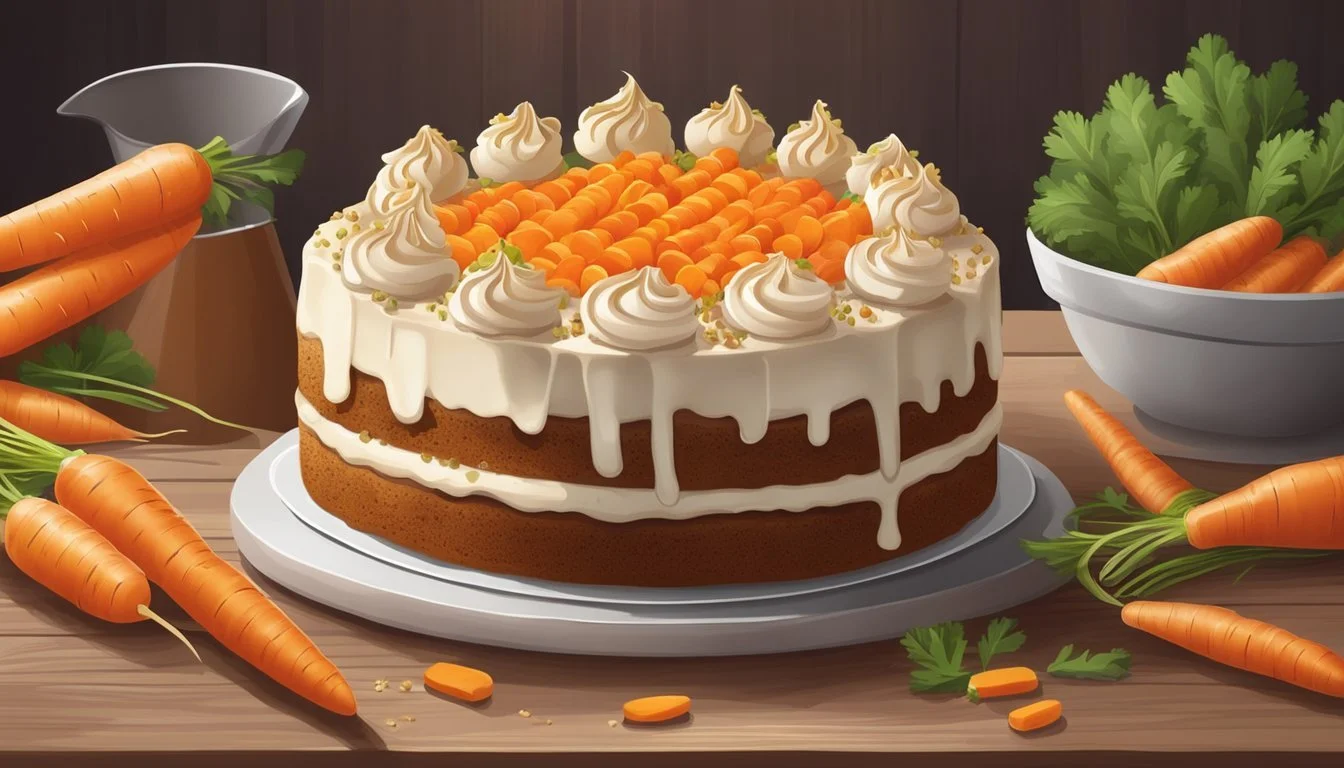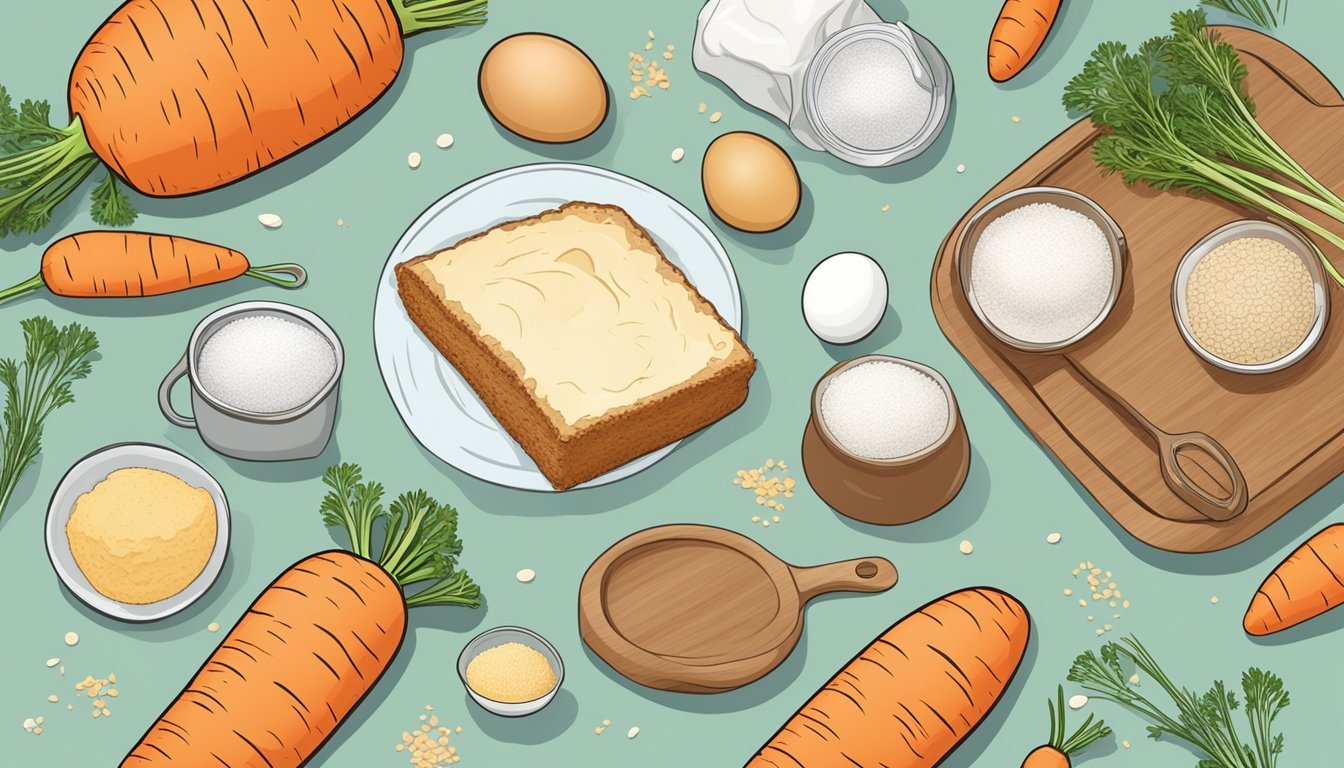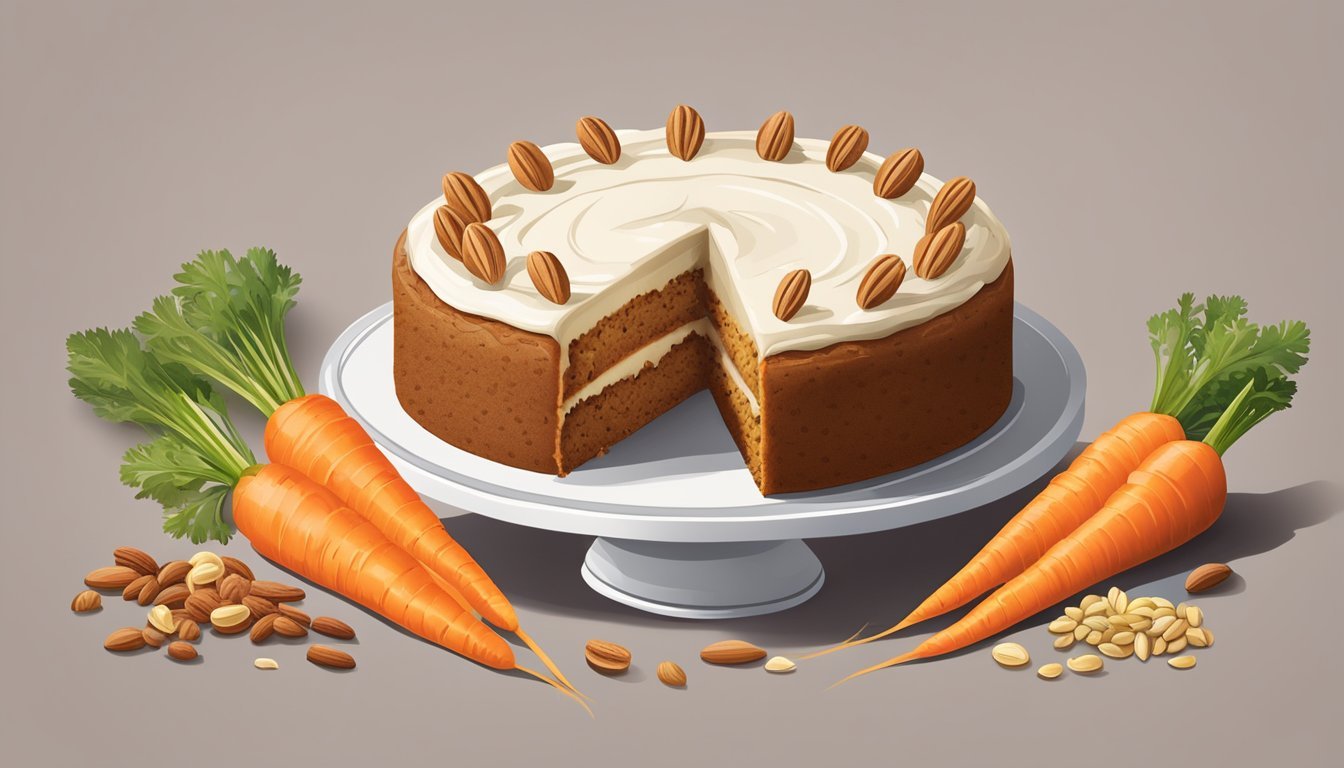Is Carrot Cake Gluten-Free?
Uncovering the Truth About This Dessert
Carrot cake is a beloved dessert known for its moist, dense texture and warm spices, often topped with a creamy frosting. Traditionally, carrot cake recipes include wheat flour, which contains gluten, a protein found in grains such as wheat, barley, and rye. Therefore, classic carrot cake is not gluten-free. However, the rising awareness of gluten-related disorders and the increasing demand for gluten-free options have led to the development of numerous gluten-free carrot cake recipes.
Gluten-free carrot cake aims to replicate the texture and flavor of the traditional version without using gluten-containing ingredients. Bakers often use a blend of gluten-free flours such as almond flour or a gluten-free all-purpose flour mix to achieve the right consistency. Ingredients like ground nuts, xanthan gum, and eggs help to bind the cake together, ensuring it remains moist and tender.
The challenge in creating a gluten-free carrot cake lies in maintaining its characteristic mouthfeel and taste without wheat flour. To address this, some recipes include additional flavor enhancers like vanilla extract or nutmeg, and texture-improving components like almond milk. As more people seek gluten-free desserts, they can now enjoy carrot cake without compromising on quality or flavor, thanks to the availability of these adapted recipes.
Ingredients Overview
Crafting a gluten-free carrot cake requires careful selection of ingredients to ensure the cake remains moist and flavorful. This involves substituting wheat flour for gluten-free alternatives, adjusting binders and leaveners, and considering allergen-friendly options.
Carrot Cake Essentials
Gluten-free carrot cake pivots on a few non-negotiable ingredients:
Carrots: Generally used grated or shredded, carrots add natural sweetness and moisture.
Eggs: Essential for structure and binding the other ingredients.
Gluten-Free Ingredients
To address the gluten-free aspect, a specific set of flours and binders are chosen:
Gluten-Free Flour Blend: A mixture of gluten-free flours such as rice, potato, and tapioca flours.
Xanthan Gum: Often added to gluten-free flour blends to mimic gluten's binding properties.
Additional Flavorings and Add-ins
Additional ingredients enhance the complexity of the cake's flavor:
Spices: Cinnamon and nutmeg are classic spice choices.
Nuts: Pecans or walnuts contribute texture and taste.
Substitutes for Common Allergens
For those avoiding dairy:
Dairy-Free Milk: Almond milk can be used in place of traditional milk.
Vegan Butter: An alternative to unsalted butter for both the cake and frosting.
Sweeteners and Frosting Components
Sugar adds sweetness while frosting provides a creamy finish:
Granulated Sugar: The base sweetener for the cake.
Powdered Sugar: Typically used in the cream cheese frosting.
Leavening Agents and Binders
Proper leavening ensures a desirable cake texture:
Baking Powder and Baking Soda: These leaveners help the cake rise.
Eggs: Apart from being essential, eggs also act as a binding agent.
Decorative and Texture Enhancements
Ingredients that add visual appeal and texture variance include:
Shredded Coconut: Offers a chewy contrast.
Raisins or Pineapple: These can be mixed in for extra sweetness and moisture.
Alternative Sweeteners and Oils
Adapting to taste or health preferences, one might choose:
Almond Flour or Coconut Flour: Nutty alternatives to traditional flour.
Canola or Vegetable Oil: Common oil choices that keep the cake moist.
Storage Ingredients
Items that help extend shelf life or maintain freshness are:
Applesauce: Sometimes used as a substitute ingredient that also helps retain moisture.
Gluten-Free Baking Techniques
When preparing gluten-free carrot cake, it's crucial to follow specific methods and use the right tools to ensure success. This segment will guide readers through the necessary steps from combining ingredients to the final assembly.
Baking Process for Carrot Cake
To begin, one should preheat the oven to the temperature specified in the cake recipe, commonly 350°F (177°C). It is important to use cake pans lined with parchment paper and possibly greased to prevent sticking. Ingredients should be at room temperature to achieve a uniform batter.
Creating the Perfect Batter
A smooth, well-mixed batter is the foundation of a fluffy gluten-free carrot cake. Start by mixing the dry ingredients in one bowl. In a food processor, combine wet ingredients until well-incorporated. Gradually mix the wet ingredients into the dry, making sure not to overmix. Spatulas can help scrape the sides of the bowl and fold in any mix-ins like nuts or raisins.
Cooking Methods and Temperature
Once the batter is poured into the prepared pans using a spatula, it should be spread evenly to cook uniformly. The cake needs to bake until a toothpick inserted into the center comes out clean, indicating it is properly cooked. Ovens can vary, so monitoring the cake towards the end of the estimated baking time is wise.
Cake Assembly Tips
After baking, carrot cakes should be allowed to cool in the pans on a wire rack for a few minutes before being turned out to cool completely. If frosting is needed, it must be done only when the cakes are cool to avoid melting. For layer cakes, one can apply a layer of frosting on one cake, then carefully place the second cake on top and press lightly to adhere.
Recipe Variations and Considerations
When it comes to adapting carrot cake to meet different dietary needs or preferences, there are several variations and considerations to keep in mind, from gluten-free alternatives to seasonal touches.
Classic vs. Gluten-Free Recipe Comparison
Traditional carrot cake recipes often include wheat flour, which contains gluten. Gluten-free carrot cake, however, substitutes wheat flour with gluten-free alternatives like almond flour or a gluten-free flour blend. Xanthan gum may also be incorporated to replicate the binding properties of gluten. The resulting cake should still be moist and tender, matching the texture of its classic counterpart.
Dairy-Free and Vegan Options
To create a dairy-free carrot cake, alternatives such as almond milk or coconut oil can be used in place of cow’s milk and butter. For a vegan carrot cake, egg substitutes like flax eggs or commercially available egg replacers can be incorporated alongside the dairy-free adjustments.
Alternative Forms of Carrot Cake
Carrot cake is versatile and can be prepared in various forms beyond the traditional layer cake. It can be made as cupcakes, muffins, or a sheet cake to suit different occasions. A sheet cake is an excellent choice for larger gatherings, while cupcakes and muffins offer convenient, individual servings.
Seasonal and Holiday Customizations
Carrot cake is a popular choice during Easter and spring holidays. To cater to seasonal festivities, one could adorn the cake with themed decorations or incorporate holiday-appropriate spices. Ingredients like cinnamon and nutmeg can enhance the warmth and flavor, making it a perfect fit for an Easter spread.
Mix-ins and Flavor Variations
The addition of mix-ins such as walnuts, pecans, raisins, or pineapple can add texture and depth to the flavor profile of a carrot cake. These ingredients can be tailored to personal preference or omitted based on dietary restrictions. It's important to ensure that mix-ins, like nuts, are also gluten-free if that is a dietary requirement.
Finishing and Presentation
The final steps of creating a gluten-free carrot cake involve careful frosting application and artistic presentation. Mastery in these areas enhances not only the visual appeal but also the overall eating experience.
Applying Frosting and Toppings
When the gluten-free carrot cake has completely cooled, one should apply a layer of cream cheese frosting generously to ensure an even coating. They should use a palette knife or icing spatula for a smooth, professional finish. Frost the top and sides of the cake, creating swirls or patterns if desired.
Toppings can include:
Crushed nuts (e.g., pecans or walnuts)
Shredded coconut
Edible flowers for a natural look
Sprinkle of ground cinnamon for extra spice
It’s important that these toppings complement the flavor profile of the carrot cake and the tangy cream cheese frosting. A precise hand will ensure the decorations are distributed evenly and tastefully.
Serving and Plating Suggestions
One should serve gluten-free carrot cake at room temperature to let the flavors shine. They can plate a slice on individual dessert plates for personal servings.
Here are guidelines for an appealing service:
Use a sharp, thin-bladed knife to cut clean slices.
Wipe the knife between cuts to avoid crumbs.
Garnish the plate with a drizzle of caramel or icing for added elegance.
Consider accompanying the cake slice with a dollop of whipped cream or a scoop of vanilla ice cream for those who enjoy extra indulgence. Presentation is paramount, and even the simplest of plates can be uplifted with attention to detail in serving.
Health and Dietary Information
Choosing a gluten-free carrot cake ensures that individuals with celiac disease or gluten sensitivity can enjoy this dessert without concern. This section examines the nutritional aspects, the basics of a gluten-free diet, and potential allergen considerations.
Nutritional Profile of Gluten-Free Carrot Cake
Gluten-free carrot cake typically uses alternative flour sources such as almond or rice flour, which can influence its nutritional content. The cake often contains carrots, which are high in vitamins A and C, and dietary fiber.
Calories: May vary depending on the use of sugar or sugar substitutes.
Carbohydrates: Predominantly from sugar and gluten-free flour.
Fats: Sourced from eggs, nuts, or oils like coconut oil. Dairy-free versions omit butter.
Protein: Provided by eggs and nuts, if included.
Fiber: Primarily from carrots and possibly nuts.
Understanding Gluten-Free Diets
Gluten-free diets omit all forms of gluten, a protein found in wheat, barley, and rye. This diet is essential for those with celiac disease or gluten intolerance, who need to ensure that their carrot cake is made with gluten-free grains.
Safe Ingredients: Rice, corn, amaranth, almond flour, etc.
Cross-Contamination: Gluten-free cakes must avoid contact with gluten-containing foods during preparation.
Allergy and Intolerance Considerations
When preparing or serving a gluten-free carrot cake, it's important to be aware of common allergens such as eggs and nuts. Dairy-free substitutes are often used for those with lactose intolerance.
Eggs: Essential for texture but can be replaced with applesauce or commercial egg substitutes for allergies.
Nuts: Optional for added texture and nutrition but can be omitted for nut allergies.
Substitutions: Always check for hidden gluten in baking powder or vanilla extract.
Individuals with allergies should verify each ingredient in the cake to prevent adverse reactions.
Storage and Freshness Tips
Maintaining the soft and tender texture of carrot cake requires proper storage methods. These techniques help to retain moisture, extending the cake's quality and enjoyment.
Proper Storage Techniques
To store carrot cake, one should:
Refrigerator: Keep it in an airtight container to maintain moisture and prevent it from absorbing other food odors.
Freezer Storage: For long-term preservation, wrap the cake tightly in cling film, then aluminum foil, and finally place it inside a freezer-safe bag or container, ensuring minimal air exposure.
Shelf Life and Quality Maintenance
Carrot cake's shelf life depends on storage conditions:
Refrigerator: The cake will typically stay fresh for up to one week when stored properly in a refrigerator.
Freezer: If frozen, it can maintain quality for up to several months. To enjoy, one should thaw the cake in the refrigerator overnight to ensure it remains moist and tender.
Frequently Asked Questions
Is Carrot Cake Gluten-Free?
Traditionally, carrot cake is not gluten-free as it is typically made with wheat flour. However, it can be made gluten-free by substituting wheat flour with a gluten-free flour blend.
What Gluten-Free Flour Can Be Used for Carrot Cake?
A gluten-free flour blend designed for baking, such as Bob's Red Mill Gluten-Free 1-to-1 Baking Flour, can be used in place of wheat flour to make a gluten-free carrot cake. It is important to look for blends that can be substituted cup for cup.
Are There Any Crucial Substitutions in Gluten-Free Carrot Cake?
Aside from using gluten-free flour, no additional substitutions are typically required. Standard carrot cake ingredients like grated carrots, sugar, and spices are naturally gluten-free.
Can I Use Any Gluten-Free Flour Blend?
While most gluten-free flour blends can be used, results can vary. Blends that include xanthan gum or guar gum tend to perform better as they mimic the binding properties of gluten.
Is Gluten-Free Carrot Cake Dry or Crumbly?
If properly prepared using the right gluten-free flour blend and correct moisture balance from ingredients like eggs and oil, gluten-free carrot cake should be moist and tender, not dry or crumbly.
Gluten-Free Flour: Essential for a gluten-free carrot cake.
Xanthan Gum: Often part of gluten-free flour blends for binding.
Moist Ingredients: Ensure the cake is not dry.
Additional Resources and References
For individuals seeking gluten-free carrot cake recipes, there are numerous resources offering a variety of recipes tailored to different tastes and dietary preferences. A critical ingredient in such recipes is gluten-free flour, with brands like Bob’s Red Mill providing options that can be used cup-for-cup in place of traditional wheat flour.
When baking a gluten-free carrot cake, ensuring the inclusion of baking powder that is also gluten-free is essential, as it is a common leavening agent needed to achieve the right texture. Ingredients like cinnamon and pure vanilla extract are key to imparting the classic spiced flavor profile expected in carrot cakes.
A hand mixer is often recommended to properly combine the wet and dry ingredients, which is a step crucial to achieving the desired consistency. To check for doneness, a cake tester or toothpick can be inserted into the center of the cake; it should come out clean when the cake is fully baked.
Below is a table summarizing tools and ingredients for gluten-free carrot cake baking, along with example recipes where they are featured:
Ingredient/Tool Description Example Recipes Gluten-Free Flour Provides structure without gluten. GFP, King Arthur Baking Baking Powder A gluten-free leavening agent. Dish by Dish Cinnamon Adds warm spice to the cake. GFP, WellPlated.com Pure Vanilla Extract Enhances flavor complexity. Gluten-free Recipe Hand Mixer Used for combining ingredients. King Arthur Baking Cake Tester Tool to test cake doneness. WellPlated.com
For further information, websites such as Gluten-Free Palate (GFP), King Arthur Baking, WellPlated by Erin, and Dish by Dish offer detailed recipes and baking tips. These resources provide guidance on making a moist and tender gluten-free carrot cake that is both delicious and compliant with dietary restrictions.
Conclusion
Traditional carrot cake recipes are not gluten-free, as they typically include wheat flour. However, those following a gluten-free diet have numerous alternatives to indulge in this classic dessert without consuming gluten.
Substituting wheat flour with a gluten-free flour blend is the most critical step in adapting carrot cake for a gluten-free diet. Gluten-free carrot cakes can be just as moist and flavorful as traditional ones, given they are prepared with the correct mix of ingredients. Binders like xanthan gum or guar gum are often added to gluten-free recipes to mimic the texture provided by gluten.
Baking Considerations:
Temperature: Most recipes suggest a baking temperature of 350°F (177°C).
Baking Time: Ranges from 35 to 60 minutes, depending on the size and type of bakeware.
Pans: Use parchment paper to prevent sticking and consider lightly dusting with a gluten-free flour, such as almond flour.
Final Touch: For a luscious finish, one can prepare a gluten-free frosting using cream cheese, butter, and gluten-free confectioners' sugar, beaten until light and fluffy.
In conclusion, gluten-free carrot cake is a delightful alternative that ensures everyone can enjoy a slice without compromising on taste or texture. The keys to success lie in careful ingredient selection and adherence to gluten-free baking techniques.








